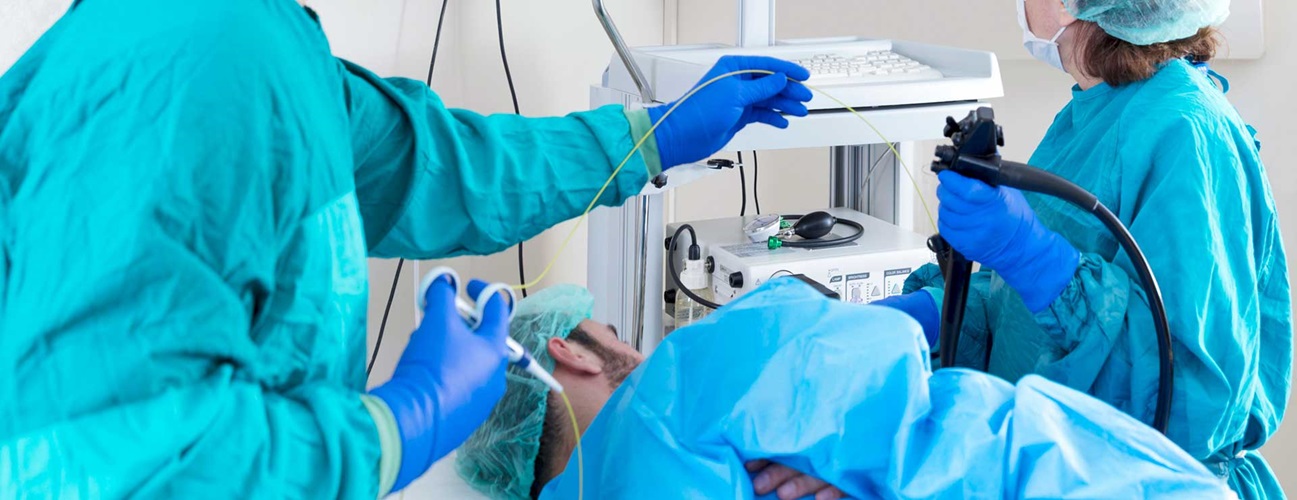Endoscopic Suturing
When gastroenterologists need to close a wound or an opening inside the gastrointestinal (GI) tract, they may use a minimally invasive procedure called endoscopic suturing.
What is endoscopic suturing?
Endoscopic suturing is a procedure that uses an endoscope (a flexible, tube-like imaging instrument) equipped with a stitching device to repair holes or openings in the GI tract. Because an endoscope can be inserted through the mouth or anus, there is no need to make a cut to access the problem area.
High-definition endoscopes let doctors see inside the body with a high degree of detail and treat problems at the same time. In some cases, gastroenterologists can use endoscopic suturing instead of open or laparoscopic surgery, which means you may have less pain and a faster recovery.
Who may need endoscopic suturing?
Your doctor might use endoscopic suturing to correct problems inside your GI tract such as:
- Gastrointestinal fistulas, which are abnormal holes or openings in the GI tract
- GI bleeding
- Perforations or tears (which may have resulted from an earlier procedure, including bariatric surgery)
- Repairing a persistent or non-healing benign stomach or duodenal ulcer
Gastroenterologists may use endoscopic suturing to close surgical wounds after performing endoscopic procedures such as:
- Removal of polyps from the intestine
- Endoscopic full thickness resection
- Endoscopic mucosal resection
- Endoscopic submucosal dissection
- Peroral endoscopic myotomy (POEM)
Other reasons for endoscopic suturing include:
- Endoscopic bariatric procedures for weight loss, such as endoscopic sleeve gastroplasty
- Anchoring a stent to keep it in place (A stent is a cylindrical device placed inside a passage or vessel to keep it open.)
Preparing for Endoscopic Suturing
Preparation for endoscopic suturing depends on the procedure you are getting. It also depends on the location of the problem area, as it determines how the endoscope is inserted. Your doctor will provide detailed instructions on how to prepare. They may involve a clear liquid diet, a fasting period, bowel prep, or a combination of these.
Make sure your doctor is aware of any allergies you may have and all the medications you take regularly, including supplements and over-the-counter medicines. Follow your doctor’s instructions regarding these medications.
Endoscopic procedures of the upper GI tract (esophagus, stomach, duodenum and small intestine) and the lower GI tract (colon and rectum) usually require sedating medication, so it is important to arrange for someone to pick you up after the procedure.
What Happens During Endoscopic Suturing
During the procedure, your gastroenterologist will:
- Insert an IV into your vein to deliver a sedative that will make you drowsy
- Place a high-definition endoscope through the mouth or anus
- Navigate the inside of your GI tract to locate the problem area
- Use either a special corkscrew-like device or the suture tip on the endoscope to place stitches into the GI wall. The stitches may be in one of several patterns depending on the best way to close the opening
- Remove the endoscope
Once the procedure is complete, you will rest in a recovery room until the sedative wears off. Your doctor will discuss your results with you before you leave.
Recovery After Endoscopic Suturing
Endoscopic suturing is a safe procedure; however, afterward, you might experience:
- Sore throat or tongue, or swollen lips if the endoscope was inserted into your mouth
- Nausea or vomiting
- Excessive intestinal gas
- Bloating or cramping
People treated with endoscopic suturing are likely to have a quicker recovery than those who had open surgery or laparoscopy to access a problem area in the GI tract. In most cases, those who had endoscopic suturing can return to usual activities within 24 hours.




